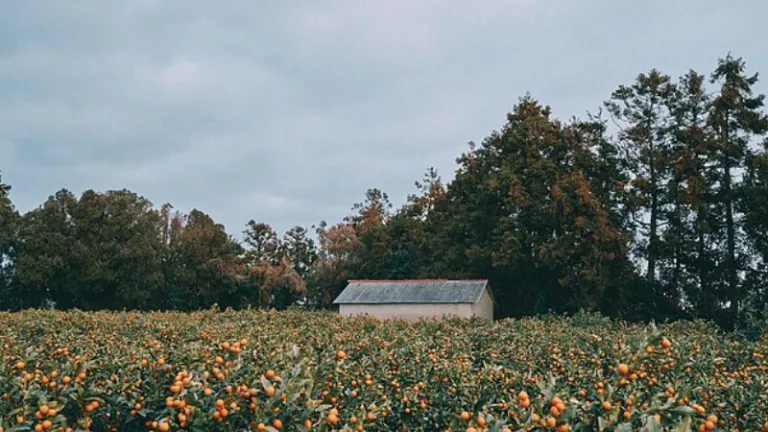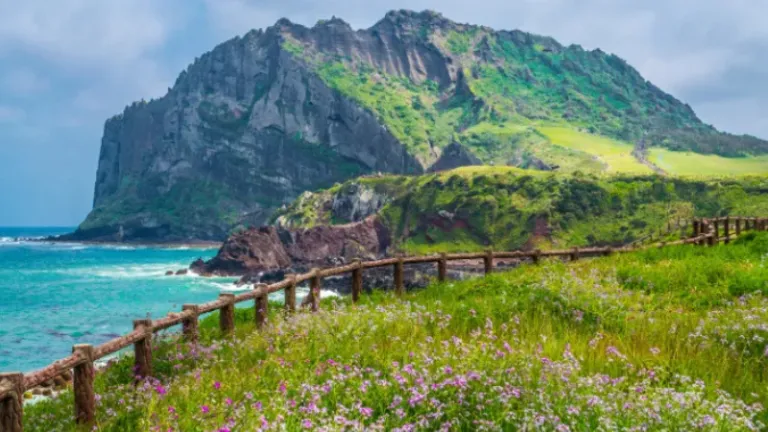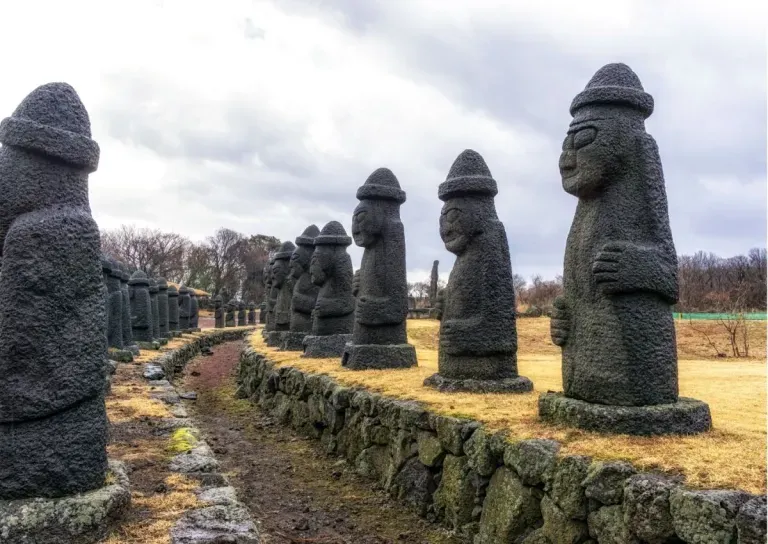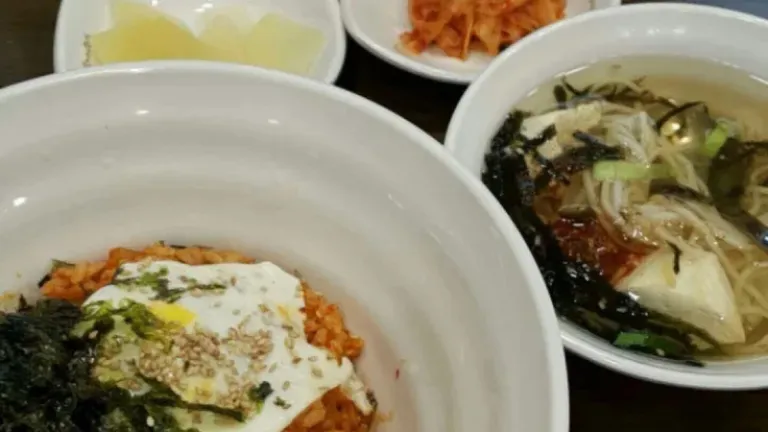Spread the good word!
5 Things You Can’t Miss in Jeju Island

Jeju Island is one of South Korea’s most captivating destinations, offering an incredible mix of natural beauty, rich culture, and delicious food. Whether you're a nature lover, a foodie, or simply someone looking to escape the hustle and bustle, Jeju Island provides a unique and meaningful experience. Here's why you should consider making this island your next travel destination.
Also read: Jeju Island Travel Guide: Best Attractions & 3-Day Itinerary
1. The Legendary Haenyeo Divers: Women of the Sea

image credit: 김형찬 | Wikimedia commons
Jeju Island’s Haenyeo divers are a cultural treasure that has been passed down through generations. These women, often in their 60s or older, dive deep into the ocean to harvest seafood, all without the aid of diving equipment. Their resilience, strength, and connection to the sea have made them an iconic symbol of Jeju’s culture.
Fun Fact: Did you know that the Haenyeo are considered one of the world’s most advanced and oldest communities of free divers? The practice dates back to the 17th century, and the Haenyeo are recognized by UNESCO for their cultural importance.
Unfortunately, the number of Haenyeo divers has been declining as the older generations pass on, with fewer young people taking up the tradition. But efforts are underway to revitalize the practice, with programs aimed at teaching younger women the art of diving. Visiting Jeju to meet these inspiring women and learn about their skills is a once-in-a-lifetime experience that brings you closer to the island's heart and soul.
2. Hallabong Tangerines: A Taste of Jeju

Image credit: Jeju Olle Foundation | Wikimedia commons
No visit to Jeju Island is complete without trying its famous Hallabong tangerines. These large, sweet citrus fruits are a staple of the island, known for their vibrant orange color, juicy flesh, and refreshing flavor. Hallabong tangerines are so beloved that they’ve become a symbol of the island.
Fun Fact: Hallabong tangerines are often called “the king of tangerines” because of their sweet, tangy flavor and their distinct crown-like shape at the top. They’re also famous for their thick peel, which makes them easier to peel than regular tangerines.
Hallabongs are used in everything from juices and cakes to cocktails and skincare products. Whether you’re enjoying them fresh or sampling Hallabong-flavored treats, this citrus fruit is a must-try that gives you a taste of Jeju's agricultural heritage. It’s not just food—it’s part of the island's identity.
3. Jeju’s Natural Wonders: A Landscape Like No Other

Image credit: Chrisinthai | Canva Pro
Jeju Island is a paradise for nature lovers, with landscapes that range from lush forests and towering mountains to pristine beaches and volcanic formations. The island's volcanic origins are evident everywhere, and its natural beauty is one of the main reasons people flock here. Hallasan Mountain, South Korea’s highest peak, offers stunning hiking trails with views that will leave you breathless.
Fun Fact: Hallasan Mountain is not just the highest peak in South Korea—it’s also a shield volcano, formed millions of years ago. It’s considered a sacred mountain and plays a significant role in the island’s folklore and spirituality.
If hiking isn’t your thing, you can still explore the island’s incredible natural features. Manjanggul Cave, one of the longest lava tubes in the world, is a must-see. As you walk through its cool, quiet corridors, you’ll be walking through a geological wonder that formed when lava flowed from Hallasan’s volcanic eruptions. This cave is not only beautiful but also an important piece of Jeju’s geological history.
And let’s not forget about Jeju’s beaches! With their soft, golden sands and clear blue waters, beaches like Hyeopjae and Jungmun are perfect for swimming, sunbathing, or surfing. Whether you want to relax or get active, Jeju’s coastal beauty will not disappoint.
Also read: How Filipinos Can Visit Jeju Island & Gangwon Province Visa-Free
4. Dive Into Jeju’s Rich Culture

Image credit: aaron90311 | Canva Pro
Jeju’s culture is as unique as its landscapes. The island’s history has been shaped by its isolated location, and over the centuries, it has developed its own customs, language, and way of life. To learn more about Jeju’s cultural heritage, you can visit one of its traditional folk villages, where you can step back in time and experience life as it was centuries ago.
Fun Fact: Jeju has its own dialect, called Jeju-eo, which is so different from mainland Korean that it’s sometimes considered a separate language. The dialect is rich with idioms and expressions that reflect Jeju’s unique way of life.
For a deeper dive into Jeju’s past, check out the Jeju Folklore and Natural History Museum, which showcases the island’s history, from its volcanic origins to its unique traditions and customs. You can learn about everything from the island’s traditional pottery to its indigenous arts, which are integral to understanding Jeju’s identity.
If you’re visiting in spring, make sure to check out the Jeju Fire Festival. This lively celebration of Jeju’s agricultural roots involves huge bonfires, traditional performances, and community dances, offering a fun and energetic way to immerse yourself in the island’s culture.
5. Jeju’s Delicious Food: A Feast for the Senses

Jeju Island is known for its delicious food, and the local cuisine is something you’ll want to savor. Jeju’s black pork is famous for its tender texture and rich flavor. This pork comes from a special breed of pig raised on the island, and it’s often grilled or served in hot pots. It’s a dish you simply cannot miss when visiting Jeju.
Fun Fact: The island’s black pigs are not only a delicious treat—they also play an important cultural role. Historically, they were used in ceremonial sacrifices and were considered sacred by Jeju’s early settlers.
For seafood lovers, Jeju is a dream come true. Being an island surrounded by the sea, Jeju is home to some of the freshest seafood you’ll ever taste. Abalone, octopus, and crabs are just a few of the local delicacies, and you can enjoy them in a variety of ways, from sashimi to soups. Many local restaurants offer seafood platters, so you can sample a variety of fresh catches in one sitting.
And if you’re into sweets, don’t miss out on Jeju’s tangerine-flavored desserts. From ice creams to tarts, the island’s signature fruit adds a refreshing twist to traditional Korean desserts.
Why Jeju is a Must-Visit
Jeju Island isn’t just a beautiful place—it’s a place full of history, culture, and natural wonders. From meeting the incredible Haenyeo divers to savoring the sweetness of Hallabong tangerines, Jeju offers a one-of-a-kind experience that will stay with you long after you leave. It’s an island where nature’s beauty meets cultural heritage, and where every moment is filled with discovery.
Fun Fact: Jeju Island is often referred to as "the Hawaii of Korea," due to its subtropical climate, stunning landscapes, and relaxing vibe. It’s the perfect getaway for anyone looking to explore a side of South Korea that’s different from the busy cities.
So whether you’re hiking up Hallasan, exploring lava caves, or simply enjoying a fresh seafood meal by the beach, Jeju Island is a destination that has something for everyone. Get ready for an adventure you won’t forget—Jeju is calling!
Published at
About Author
Jeliefer Sumaya
Subscribe our Newsletter
Get our weekly tips and travel news!
Recommended Articles
10 Commandments for Responsible Travel Flexing 10 Fairytale Castles In Europe Filipinos Need To See! Permission to feel like royalty even for a day?!
10 Family Outing Ideas in Metro Manila Under ₱500 Looking for a weekend bonding with the family under ₱500? Head to these places, pronto!
10 Fun Things to Do in Manila Alone Live your best life in Manila, even when you’re riding solo.
Top 10 Post-Breakup Destinations for Healing and Self-Rediscovery Ready for a solo travel?
Latest Articles
10 Airbnb Rentals In Boracay Perfect For a Quick Family Vacation Check out these cosy, fun, and convenient Airbnb stays!
Ilocos Norte Travel Guide: Where and How to Go Discover the best of Ilocos Norte!
Where to Find the Best Korean-Themed Cafes in the Philippines Here are the trendiest Korean cafés in the Philippines!
Photography Etiquette in Japan: What Travellers Must Know Essential tips for respectful photography in Japan.
Monkey Bay Thailand: What Filipino Travellers Should Know Before Travelling One year after the scare

